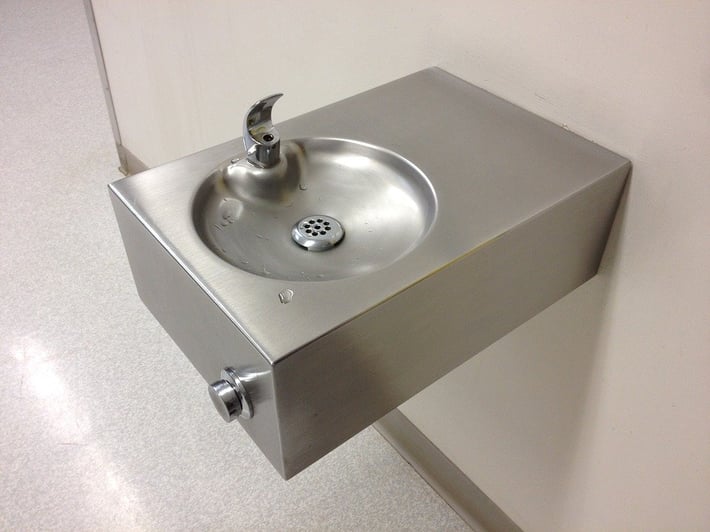
Across the USA, there are only 8,000 schools and childcare centers that are regulated under the Safe Water Drinking Act (SWDA).
That means, there are about 600,000 childcare centers and schools that are not regulated under the SWDA.
That is a lot of unregulated schools.
What’s the difference?
Schools that are regulated maintain their own water supply and are required to regularly test their drinking water quality to make sure it is up to standard. Schools that are not regulated are not required to test their water quality, which can leave much to be desired in terms of maintenance.
Why does this matter?
As an engineer, you have an obligation to the safety of the building’s occupants.
While there may be local regulations on drinking water quality, there is no federal enforcement of these regulations. This means it falls to the schools themselves to test for lead in the school drinking water, and everyone involved in the construction or maintenance of that school has a role to play in protecting water quality.
Effects of Lead in School Drinking Water on Children's Health
 Source: epa.gov/ground-water-and-drinking-water/3ts-reducing-lead-drinking-water-toolkit
Source: epa.gov/ground-water-and-drinking-water/3ts-reducing-lead-drinking-water-toolkit
Children are at a much higher risk of getting lead poisoning than adults, due to their smaller body size. Children who are found to have even small amounts of lead in their blood are at risk of developing learning disabilities, shorter stature, impaired hearing, and other disorders.
That is why the 2014 water crisis in Flint, Michigan affected children more than any other demographic. During the water crisis, the municipal water supply was inappropriately treated, poisoning thousands of residents with lead. Many of the children affected still suffer from impaired development, both mentally and physically.
Sources of Lead in School Drinking Water
As an engineer responsible for the construction or maintenance of a building, it’s important to consider all sources of potential contamination. The Environmental Protection Agency (EPA) identifies the following sources of lead contamination in drinking water:•
-
Faucets: Different fixtures in the building may contain lead, including the school water fountain.
-
Copper Pipe with Lead Solder: Solder that was made or installed before 1986 had high levels of lead.
-
Galvanized Pipe: Lead molecules can attach to the surface of galvanized pipes, causing elevated lead levels in drinking water.
-
Lead Service Line: The service line connects the water main to the building’s internal plumbing. Lead service lines are often a major source of lead contamination in water, as there are an estimated 7.3 million lead service lines still in use today.
-
Lead Goose Necks and Pigtails: These are shorter pipes that connect the service line to the main. These can be made of lead, which can introduce another source of contamination to drinking water.
How to Prevent Lead in School Drinking Water
To prevent lead contamination in school drinking water, the EPA outlines a plan they call the “3Ts for Reducing Lead in Drinking Water”, complete with a 7-module toolkit to help schools implement the plan. Chicago Faucets highlights the plan below.
1. Training

The first part of the plan largely concerns education and communication.
School officials need to make a concerted effort to educate themselves on the health effects of lead contamination, the signs of poisoning, the sources of lead contamination, and how lead gets into drinking water. The EPA helps with education by providing educational materials in its toolkit. Additionally, it’s important to familiarize yourself with state and municipal regulations.
Next, communication is emphasized. Roles and responsibilities will need to be assigned, and partnerships with the appropriate authorities will need to be established.
For example, you might want to develop partnerships with the public water organization, the local health office, the state drinking water program, certified laboratories, or local community organizations. Familiarizing yourself with the different resources available will help everything run smoother.
Finally, the school should keep its community, parents, staff, and partners in the loop regarding its efforts to test drinking water quality.
2. Testing
The next part of the plan involves testing the water quality. The school will need to collect samples according to a predetermined plan and send them off for testing at an appropriate facility. Samples need to be collected on a regular schedule to yield meaningful results.
This part also includes investigative work such as conducting a walkthrough of the facility to understand the complete picture of the plumbing system. This will also involve searching through records and contacting authorities to determine if the water main is made of lead.
3. Taking Action
Finally, the school needs to be prepared to act on the results they receive. A remediation plan should be established ahead of time, as well as a system to ensure the plan is followed.
Short-term and long-term measures should be established, and results recorded to measure historical progress.
Clean Drinking Water is Everyone's Responsibility

Drinking water quality shouldn’t be taken for granted.
In homes, it is easy to remember that you are responsible for the maintenance of the building, but when it comes to public buildings, it is easy to shirk responsibility for common resources like the water supply.
However, clean drinking water in public places is everyone’s responsibility. To ensure schoolchildren have access to clean drinking water, teachers, engineers, parents, and the government each have a role to play in securing clean water in schools.
Make sure you do your part. Browse our selection of products including water bubblers for schools to see which products are best for your needs.
.png)

